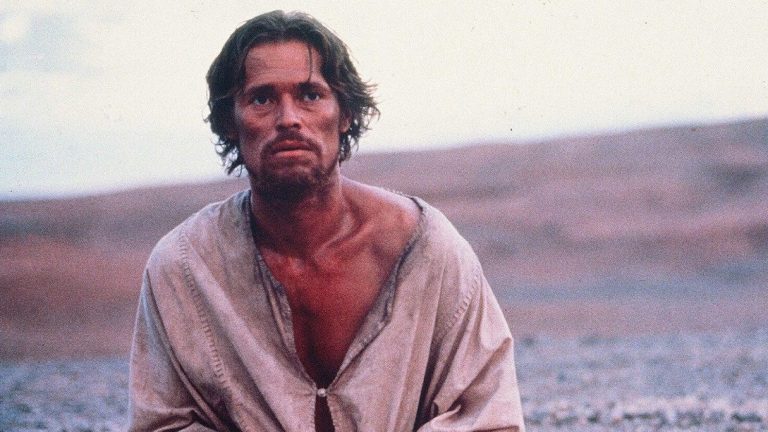Hail The Last Temptation of Christ! The Movie That Made Jesus a Scorsese Antihero
Martin Scorsese waited years to make The Last Temptation of Christ, a controversial film that dared to imagine Jesus being as human as... a Scorsese hero.

When Martin Scorsese was just 11 years old, he storyboarded a cinematic epic named “The Eternal City,” which he described as “a fictitious story of Royalty in Ancient Rome.” It was envisioned to film in 75mm CinemaScope and star Marlon Brando, Richard Burton, Virginia Mayo, and Alec Guinness. This remains a fascinating, ambitious artifact that’s been shared far and wide online. But perhaps just as interesting are the storyboards critic Richard Blake describes in his book After Image: The Indelible Catholic Imagination of Six American Filmmakers. According to Blake, Scorsese, aged 10, drew even earlier the Stations of the Cross: images of Jesus Christ’s final days and moments before death.
Many years later, Scorsese would at last film his version of those events in The Last Temptation of Christ, and the result was one of the most controversial films of all time.
Christianity has a deep and enduring impact on Scorsese’s work. Raised by parents of Italian descent in New York City, Scorsese was born a Catholic and his feature-length directorial debut, 1967’s Who’s That Knocking at My Door, concerns a young, misogynistic Italian-American man played by Harvey Keitel, who struggles with the idea of loving a woman after she is raped—for she is seen as being sullied in the eyes of his faith.
Who’s That Knocking at My Door is a challenging film that establishes many of the themes Scorsese would later tackle. There’s the woman—labeled as only “girl”—who is held up as an angelic vision until, later on, Keitel’s J.R. realizes she’s actually a fully formed person with her own difficulties and desires. There’s the use of Catholic imagery too, such as Cathedrals and the Virgin Mary. And then there’s the Catholic guilt that riddles the central character, something that the filmmaker would reckon with time and time again.
Six years after his debut, Scorsese released Mean Streets (1973). Its lead character, Charlie Cappa, once again played by Keitel, grapples with his Mafia work conflicting with his Catholic faith. For Taxi Driver (1976), Scorsese was less explicit. Rober De Niro’s Travis Bickle, a Vietnam veteran who has PTSD, and wants to purge the streets and himself of sin. In the book Scorsese on Scorsese, the director describes Bickle’s aspirations as saintly, even if his bloodthirsty methods are, at times, twisted.
In Raging Bull (1980), De Niro’s fighter Jake LaMotta has a crucifix above his bed. He struggles with infidelity and sexual desires, telling his second wife that he cannot have sex before a fight—sex is a sin that distracts him from being a champion boxer, a contender. Some critics have noted that LaMotta is a martyr who can be redeemed through the bleeding of his body and spirit, and it’s a theme Scorsese would return to in just a few years. Indeed, his future protagonist would borrow characteristics from nearly all his past onscreen heroes. Scorsese would finally return to the spiritual leader he was first drawn to at only 10 years old: Jesus Christ.
Jesus Christ Scorsese Star
Catholocisim was never far away from Scorsese’s work, but The Last Temptation of Christ put a laser focus on his faith. Scorsese was first given a copy of Nikos Kazantzakis’ novel on the set of 1972’s Boxcar Bertha by Barbara Hershey, who played that film’s eponymous character and would go on to portray Mary Magdalene in Last Temptation. The book was optioned in the late 1970s and Scorsese secured financing in 1983; however, Paramount soon withdrew from the project after the budget ballooned and multiple letters of protest were sent to the studio.
Devout Catholics had gotten word that Kazantzakis’ novel was being adapted for cinema. The book was banned by various Christian groups for “slanders” against Jesus because the story sees Christ grapple with human desires including a want for a normal life, a wife, and children. This stands in opposition to many religious leaders’ perfect image of Jesus.
Despite the opposition, come 1986, Universal showed interest in the project and offered to make it on the promise that Scorsese would direct a more mainstream movie at a later date, the outcome of which was Cape Fear (1991).
As had been foreshadowed by The Last Temptation of Christ’s first cancelation, certain sectors of Christendom started protesting the film almost immediately as it entered production again and then even more vehemently when the film–written by Scorsese’s Taxi Driver and Raging Bull screenwriter Paul Schrader–was playing in cinemas. Things reached a fever pitch.
Catholic nuns were reported as calling it blasphemous; Roger Ebert wrote how Scorsese received death threats; the evangelist Bill Bright—who had previously produced a movie titled simply Jesus—offered to buy the film’s negative from Universal in order to burn it; and a cinema in Paris was set on fire while the film played. The terrorist attack was blamed on a far-right Christian group. In Singapore, Kazantzakis’ novel, which had been selling in bookstores for 30 years, was banned from the country. Despite everything, Scorsese was nominated for Best Director at the Oscars, though the film received no other nominations.
Why was this movie, made by a man who had wrestled with his faith on screen for over two decades, so controversial? The simple answer is that Scorsese’s Jesus is not the Jesus of the Bible.
“This film is not based upon the Gospels but upon this fictional exploration of the eternal spiritual conflict,” warns the opening crawl. Indeed, when we first meet Jesus, played by Willem Dafoe, he is a carpenter making crucifixion crosses for the Romans and is plagued by voices that render him almost paralytic. His friend Judas, portrayed by Keitel, chastizes him for collaborating with the Romans.
For much of The Last Temptation of Christ, Jesus is more man than God. He has sexual desire and shows survival instincts that go against his true calling; dying for our sins. There are moments where I, as a viewer, am frustrated with the way the story becomes almost too akin to the gospel as Jesus turns water into wine and raises Lazarus from the dead. It’s as if Scorsese wants to apologize for the rest of the movie being so off-book. It’s also evidence that he wanted to present a version of Christ who wasn’t simply blasphemous, but a Jesus who was both the Son of God and has human suffering.
The eventual denouement is breathtaking. Jesus is finally nailed to the cross and calls out to his father, God, to help him. A young angel appears and offers to bring him down from the cross. They say that God is pleased with his sacrifice, but that Jesus is not actually the Messiah. Jesus, invisible to all others, steps off the crucifix and goes on to live a happy life, marrying Mary Magdalene and having children.
This, however, is all a trick by the Devil. A returning Judas, having discovered that Jesus is alive, chastizes him for having not died on the cross. The Devil (Leo Marks) appears before him, but Jesus, on his deathbed, repents. He returns to the cross and begs God to let him be the Messiah, which God accepts. Having overcome the last temptation, Jesus is once again crucified. “It is accomplished!” he exclaims.
The Scorsese Way
In almost every adaptation of the gospels, both before and after The Last Temptation of Christ, Jesus is perfect. He is, after all, the Son of God. But Scorsese’s version is fascinating in that Jesus is a flawed man akin to many of Scorsese’s other leads. Where J.R. has an inner conflict of faith, so does Jesus. Where Travis Bickle wants to cleanse himself and the world of sin, so does Jesus. Where Jake LaMotta is distracted by sexual desires, so too is Jesus. It’s those aspects that make Scorsese’s version of Jesus so unique and interesting, and controversial.
It’s also worth noting that Scorsese protagonists are violent—toward the world, toward themselves, and often toward women. Scorsese’s Jesus doesn’t go on killing spree but he does make the wooden crosses the Romans use for crucifixion. Likewise, his self-imposed solitude in the desert is a battle with both himself and the Devil; Jesus tortures himself. However, Jesus is also better than J.R. and Bickle and LaMotta. He is still our saviour–half-man, half-God– but Scorsese gives him a character arc rather than accepting him as immediately perfect. It makes for a good movie, but it’s not the Jesus many Catholics want to accept.
“The beauty of Kazantzakis’ concept is that Jesus has to put up with everything we go through, all the doubts and fears and anger,” Scorsese told FilmComment in 1988. “He made me feel like he’s sinning—but he’s not sinning, he’s just human. As well as divine. And he has to deal with all this double, triple guilt on the cross. That’s the way I directed it, and that’s what I wanted, because my own religious feelings are the same. I do a lot of thinking about it, at lot of questioning, a lot of doubting, and then some good feeling. A lot of good feeling. And then a lot more questioning, thinking, doubting!”
Scorsese later made a public statement following public outcry over the film, renewing his faith and trying to make his viewpoint even clearer: “It is more than just another film project for me. It was made with conviction and love and so I believe it is an affirmation of faith, not a denial. Further, I feel strongly that people everywhere will be able to identify with the human side of Jesus as well as his divine side.”
With so much outrage, The Last Temptation of Christ was not a major box office success. Made on a budget of $7 million, a sum significantly less than the original $14 million that Scorsese pitched when trying to make the movie in 1983, it grossed just over $8 million in the U.S., and an additional $8.8 million around the world. Catholic picketers stood outside cinemas and put people off seeing the movie. As a result, the film went somewhat underappreciated for a number of years, finding itself placed often in the middle when critics rank Scorsese’s filmography.
Perhaps by some miracle, the movie’s premiere led to another revelation for Scorsese: “After the premiere a group of us went to dinner at the Regency hotel,” he told the New York Times in 2016. One of those people was Paul Moore, the Episcopal bishop of New York, who had written public statements in support of The Last Temptation of Christ, saying it dramatized many of the core teachings of Jesus. It was during that dinner that Moore handed Scorsese a copy of a book that would haunt the filmmaker’s thoughts for over 25 years: Shūsaku Endō’s Silence, which was about two priests who travel to Japan to spread the word of God. Scorsese finally released his filmed version of the story in 2016.
The Last Temptation of Christ, though, remains something of an enigma. Whereas Easter TV schedules are filled with reruns of King of Kings, The Ten Commandments, and even the problematic The Passion of the Christ, Scorsese’ work is still often missing. If he hadn’t wanted to cause outrage he could have taken notes from his 11-year-old self; borrow from classic epics like Ben-Hur (1959) and have a perfect protagonist who lives without sin. But that’s not Scorsese’s way. Instead we ended up with The Last Temptation of Christ, a movie too sinful for the religious, and arguably too religious for the sinful.
